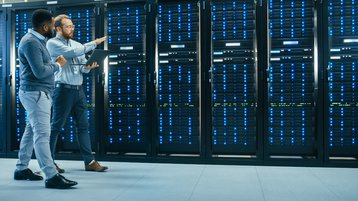In the rapidly evolving digital landscape, data centers have become the backbone of our technology-driven society. These mission-critical facilities require impeccable management to ensure smooth operations and mitigate risks.
While technological advancements have significantly improved data center infrastructure, the human element remains a crucial factor to consider. It is essential to recognize the importance of human factors in the data center industry and understand the key principles and theories that come into play.
The integration of human factors and DCIM tools
Just as a well-choreographed dance performance requires each dancer to understand their movements and coordinate with precision, data centers demand the perfect integration of human factors and Data Center Infrastructure Management (DCIM) tools. Human factors, or ergonomics, focus on optimizing the interaction between humans, technology, and the environment to enhance performance, efficiency, and safety.
DCIM tools, like skilled choreographers, guide the operations within a data center. These tools provide real-time monitoring, predictive analytics, and automation, allowing better decision-making and optimizing performance.
Analogizing the integration of human factors and DCIM tools to a dance, we can visualize a synchronized performance where each dancer's movements (representing the human element) align seamlessly with the rhythm and direction set by the choreographer (representing the DCIM tools). Similarly, the integration of human factors and DCIM tools in data centers enables organizations to optimize employee performance and minimize the risk of errors.
Importance of human factors in the data center industry
Data centers involve complex and high-stress environments where a small mistake can lead to significant consequences, financial losses, and customer dissatisfaction. Ignoring human factors can undermine the effectiveness and efficiency of data center operations.
One key principle of human factors is the concept of human performance limitations. Humans have cognitive, physical, and emotional limitations that can affect their ability to perform under various circumstances. Understanding these limitations allows organizations to design systems that accommodate and optimize human performance.
For example, workload management is crucial in data centers. Overloading employees with excessive tasks can hamper their performance, increase the risk of errors, and compromise decision-making. By considering human factors principles, such as workload optimization and task allocation, organizations can ensure employees have manageable workloads, leading to improved efficiency and reduced stress levels.
Another essential principle of human factors is user-centered design. This approach emphasizes designing systems and tools that match the capabilities, limitations, and preferences of the end-users. User-centered design enhances usability, reduces errors, and improves overall productivity.
By implementing user-centered design principles in data centers, organizations can develop intuitive user interfaces, clear communication channels, and efficient processes that enable employees to operate effectively and minimize the risk of errors.
Just as a dance routine tailored to the strengths and abilities of the dancers allows for flawless execution, a user-centered design in the data center environment facilitates smooth operations and decreases the potential for catastrophic errors.
Understanding the key principles and theories of human factors
To effectively manage human factors in data centers, it is crucial to have a solid grasp of key principles and theories that come into play. Here are three foundational principles worth considering:
- Situational awareness: Situational awareness refers to the individual's perception and comprehension of their environment and understanding the context within which they are operating. In data centers, situational awareness is crucial for identifying critical events, monitoring system health, and making informed decisions. DCIM tools provide data that enhances situational awareness, enabling quick reactions and effective problem-solving.
- Teamwork and communication: Effective teamwork and communication are vital in high-pressure environments, such as data centers. Teamwork relies on clear roles and responsibilities, collaborative decision-making, and efficient communication channels. By fostering a culture of teamwork and communication, data centers can optimize performance, reduce errors, and enhance overall safety.
- Human error and error management: Recognizing that human error is an inherent part of complex systems, data centers must develop strategies for error management. One effective approach is to implement error-prevention techniques, such as using checklists, standard operating procedures, and training programs to minimize the occurrence of errors. Additionally, organizations should encourage a non-punitive reporting culture, where employees feel comfortable reporting errors and engaging in continuous improvement.
Embracing the future: AI tools and employee optimization
As we look to the future, it is evident that new technological advancements, such as artificial intelligence (AI), will play an even more significant role in data center operations. AI-powered tools have the potential to revolutionize how we manage human factors in data centers, optimizing employee performance and minimizing the risk of errors.
Imagine an AI tool acting as a skilled dance partner, seamlessly adapting to the rhythm and movements of the dancers (representing employees) to enhance their performance. AI tools integrated into DCIM systems can analyze vast amounts of data in real-time, identify patterns, and provide actionable insights for decision-making and process optimization. These AI tools can help data centers proactively address potential issues, predict maintenance requirements, and optimize resource allocation.
The integration of human factors and DCIM tools is crucial for optimizing data center operations, enhancing performance, minimizing risks, and embracing the future. By focusing on key principles and theories of human factors, such as workload management, user-centered design, situational awareness, teamwork, communication, and error management, organizations can create an environment that optimizes employee performance and minimizes the potential for errors.
Data centers are the backbone of our digital world, and human factors play a vital role in achieving their full potential. Embracing the integration of human factors and DCIM tools, along with the future integration of AI-powered tools, will pave the way for improved efficiency, reliability, and safety in data center operations, ultimately benefiting organizations and their customers in the digital age.
By combining the power of human expertise with advanced technological capabilities, we can ensure data centers continue to thrive as the core pillars of our digital infrastructure.





